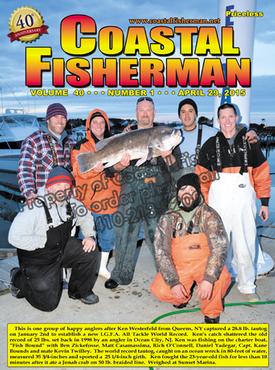


Article by Capt. Steve Katz
 Modern marine electronics are not needed to signal that spring has arrived. A drive through the local marinas will confirm everyone is getting their boats ready for the fishing season. After this winter’s record breaking cold weather, some extra checks are needed before heading out to sea.
Modern marine electronics are not needed to signal that spring has arrived. A drive through the local marinas will confirm everyone is getting their boats ready for the fishing season. After this winter’s record breaking cold weather, some extra checks are needed before heading out to sea.
Always on the top of my list are the boat’s batteries. Partially charged batteries can easily freeze, damaging them permanently. A fully charged battery should test or read 12.65 volts. Anything less is a concern and should be investigated. Other battery tests can and should be conducted if the battery seems to have a problem or is not taking a charge. A traditional load test or the conductance testing should be done. A conductance test is often available at battery retailers at no charge. This is a quick test that reports the capacity in cold cranking amps (CCA) or similar rating and often gives a status of the batteries health. If you think you have a faulty battery, it should be replaced, allowing for a trouble free summer.
A quick note on battery types, cranking batteries are made to supply a lot of power in a short burst (to start an engine). Deep cycle batteries are designed to supply moderate power for a long duration (to supply electronics). Unlike starting batteries, deep cycles batteries can withstand the effects of continual deep discharge and recharge.
Another critical area to be checked this spring are the bilge pumps, especially after the deep freezing this past winter. Each bilge pump should be checked for operation on manual mode and on automatic mode. Also check the discharge hoses to be sure the hoses and fittings have not cracked.
Moving up to the helm and your navigation electronics, now is a good time to connect and power up each piece of equipment, (NOTE fishfinders/sonar transducers should not be powered on while out of the water.) Turn on your VHF radio, conduct a radio check, listen to the marine weather and be sure all functions are operating properly and that your transmission and reception are loud and clear. Check the GPS signal reception on your chart plotter and navigation equipment and review built-in or ad-on chart electronics. Review your waypoints, confirming that all of your data is still there from last year. Operate the radar briefly, confirming the system is picking up and displaying targets as expected and that they are plotted on the screen in the proper orientation.
Since last season, most of the marine electronics manufacturers have released updated software for many types of hardware. While it is not always mandatory to update your equipment’s software, you should ask a marine electronics technician to check for and install software updates as necessary. You can also contact the manufacturer to determine if a software update is available and is needed. If you have added a new component to an electronic system, a software update is often mandatory for proper functionality.
While it may seem obvious, now is a great time to install a new or replacement transducer while your boat is out of the water. Transom mount, thru-hull or in-hull, there are many transducers that can improve your existing sonar.
A CHIRP style transducer is a popular upgrade this spring, with many different styles available, such as tilted element thru-hull for smaller and midsize boats and pocket mount (into the boats hull) for larger boats. If adding a CHIRP transducer, the display unit needs to be CHIRP compatible, either using an add-on sonar module or one of the modern displays that have CHIRP capability built-in.
Also this season, side view or down view transducers are popular, often complimenting the traditional fishfinder sonar. Combined with a matching display unit, these high frequency transducers (up to 800kHz) display an image of objects (hopefully fish) in the water both below and/or to the side of the boat. The higher frequency transducers have shorter wavelengths and more cycles per second, producing a more detailed image but at a reduced range as compared to traditional frequencies. Originally popular with freshwater fishing, where searching for bottom structure is important, the technology has moved to saltwater, allowing boaters to “see” the water off to the sides of their boat and provide “photographic type” imaging of the water column below the bottom of the boat, often identifying the baitfish that attract larger fish.
Whether in Ocean City, Maryland, Ft. Lauderdale, Florida or Miami, Florida, this winters boat shows were an opportunity to see and learn about many new marine electronic products. If you missed anything, I will review some of the new products in the weeks to follow.
Captain Steve Katz is the owner of Steve’s Marine Service and holds NMEA, AMEI and NMEA2000 certificates along with ABYC Master Technician certification and factory training from many manufacturers.